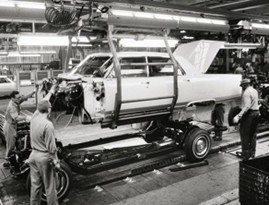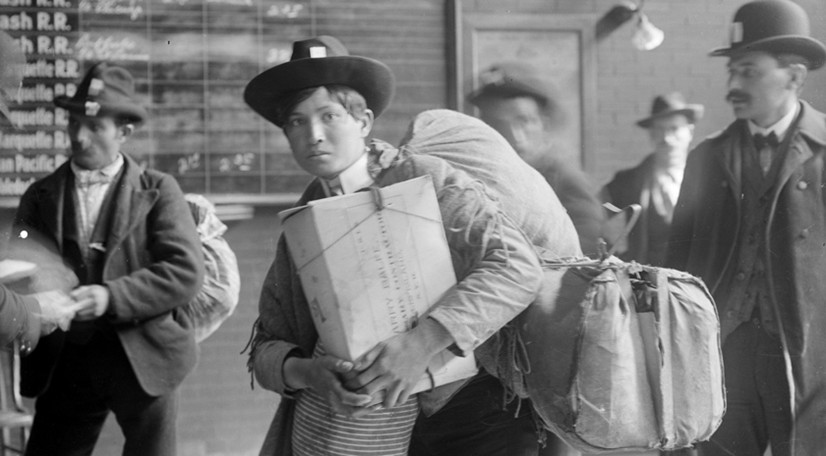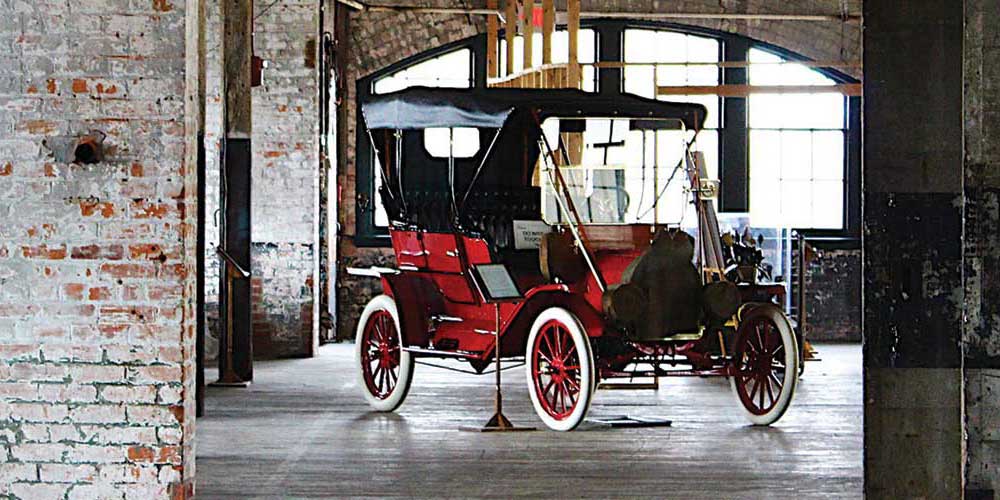by Ron Alpern
Images Courtesy of the Reuther Library at Wayne State University and the Detroit Historical Society
Published 9.17.2025
 The Cadillac Clark Street Plant Body Drop in the 1970s.
The Cadillac Clark Street Plant Body Drop in the 1970s.
The oversized shadow that Detroit cast over the emergence of the auto industry in the 20th century presents a challenge for those trying to interpret and preserve that legacy. The era’s depth and complexity have made it a particularly daunting task for the volunteers and scholars who developed, over more than a decade, the Southwest Detroit Auto Heritage Guide, a feature of the MotorCities website now live at https://www.motorcities.org/southwest-detroit-auto-heritage-guide.
The Guide seeks to introduce the innovations of auto pioneers and challenges faced by manufacturers in a dynamic, volatile industry to students, residents, and tourists alike. It pays tribute to those who relocated from near and far to work in its factories, as well as those whose helped revitalize organized labor in the era following the Great Depression. The Guide also offers researchers, auto enthusiasts, and union activists a wealth of detail often overlooked in accounts that focus on Detroit at large, rather than on a single neighborhood.
The Guide’s introductory profiles, essays, videos and links to other sources attempt to do justice to the Motor City legacy. As visitors explore those resources, we hope they will consider ways they can aid the effort to add more stories of the people, places, and things that deserve to be added to the site.

Auto Heritage Guide Features
Firms & Sites: Recommendations found at the beginning of this section offer a path through the Guide that traces, in chronological order, the first half of Detroit’s first auto century. American Car & Foundry, the nation’s largest producer of railcars in the latter part of the 19th century, was located on the site of what became General Motors’ Cadillac Clark Street operations. In the months before the crash of 1929, the Employer Association of Detroit’s “Labor Barometer” payroll report noted that 105,000 workers labored at Ford Motor Campany’s Rouge complex and Lincoln Motors operations. The combined employment at Graham-Paige, Michigan Copper & Brass, and Timken Detroit Axle surpassed 8,500. GM’s Clark St Cadillac facility employed more than 5,500, while the Fleetwood and Ternstedt operations comprised a substantial portion of GM’s Fisher Body’s citywide payroll of more than 16,000 employees.
Other posts trace Ford’s evolution from the world’s first vertically integrated auto industrial operation in the 1930s through seven decades later, when its Rouge Assembly plant was turned into an example of ecofriendly, sustainable manufacturing. The Michigan Central Station profile reminds us that the Station in its heyday could be regarded as Detroit’s Ellis Island for the thousands from throughout the country and world who sought work here during the auto boom years. Ford’s billion-dollar commitment to transform the Station, which had been abandoned for almost five decades, into the hub of its effort to develop autonomous vehicles is also described.
 Arrivals at the Michigan Central Station, date unknown.
Arrivals at the Michigan Central Station, date unknown.
Those posts and the profile of the supply chain management firm The James Group International underscore the continuing commitment that manufacturers are making to the area. We extend an open invitation to other auto businesses to collaborate on additional histories that belong in this section.
Community History: The Guide’s essays in this section provide additional context. They chronicle the area’s 19th century industrial roots, the early years of the auto boom, and the challenges facing the industry since the end of World War II. They also focus on neighborhood events that figured prominently in transforming Detroit from a bastion of anti-unionism into one of America’s premier union towns in the 1930s and beyond. The most recent additions highlight the ties of African Americans, Latino/as and Native Americans to the auto industry. The Guide hopes to expand those discussions to explore the neighborhood’s Arab American, Irish, Italian, Maltese, and Polish/Eastern European residents. The Guide’s initial version of the “Disinvestment and Revitalization” essay also welcomes anyone interested in developing items referenced there.
In honor of Hispanic Heritage Month, viewers may want to access the "Hank Aguirre Mexican Industires" Communuty History profile which honors the minorty pioneerign automotive supplier and Tigers baseball legend.
Labor Roots: While many of the posts in this section are linked to other sections of the Guide, this is where people interested in the neighborhood’s labor history can find discussions of the 1932 Ford Hunger March protest, the sit-down strikes and organizing campaigns that launched the United Automobile Workers’ union, and the career of Walter Reuther in the decades prior to World War II.
The We “Auto” Know More section features a list of auto-related companies, labor unions, and cultural communities whose contributions to the history of Southwest Detroit have yet to be developed. New volunteers can email: This email address is being protected from spambots. You need JavaScript enabled to view it. to discuss ways they can aid with future posts that highlight entities noted here.
Finally, Help Build the Guide introduces contributors to the Guide.
Explore the Auto Heritage Guide at www.motorcities.org/southwest-detroit-auto-heritage-guide.


